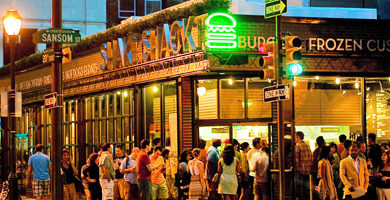Hospitality with a side of environmentalism: Shake Shack’s responsible sustainability practices

Examining Shake Shack's enlightened approach to restaurant sustainability and minimizing its global footprint.
Born in 2004 in Manhattan’s Madison Square Park, Shake Shack grew up having an environmentally conscious ethos. Its popularity and business success directly supported the Madison Square Park Conservancy and empowered the non-profit to support a sweeping revitalization of the park. [1] Now, Shake Shack’s global footprint has expanded to include 84 destinations across 10 countries and 45 cities, and has created impact that has far transcended its small home in New York. [2] Founded by Danny Meyer, Shake Shack’s business is marked by “enlightened hospitality” detailed in Meyer’s book, Setting the Table. However, it also demonstrates forward-thinking sustainability efforts, which include innovative store design, recycling initiatives, and carefully selected supplier relationships. [3] These initiatives are thorough and offer a model for responsibly addressing climate change.
What does climate change have to do with a burger joint?
Burgers, milkshakes, beer… Deconstructing Shake Shack’s menu reveals the company’s deep exposure to agriculture industries highly sensitive to climate change. Its array of Brooklyn Brewery beers require large quantities of water for production [4], and its Stumptown Coffee offerings are strongly affected by changing temperatures impacting global coffee bean yields. [5] However, perhaps at the forefront of its concerns, is its reliance on livestock-based ingredients for the bulk of its menu. Not only does livestock demand significant amounts of resources (land, crops, and water), it also causes significant damage to the environment and is responsible for 8% to 18% of global greenhouse-gas emissions. [6] Cattle is the biggest contributor and disproportionately accounts for 77% of emissions per 59 million tons of protein, compared to pork and poultry, which together account for 10% per 215 million tons. [7]
So what can Shake Shack do?
As a thought leader in the restaurant industry, Shake Shack’s biggest opportunity to play an active part in climate change is through its selection of supplier relationships. That starts with the menu that it chooses to define. As Shake Shack grows internationally, the company has the power to shape the world’s view of a premium “American diner” by controlling its supply to influence customer demand for menu options. Shake Shack increasingly offers an array of non-beef options [8], including its ‘Shroom Burger and Chick’n’Shack (debuted January 2016 [9]). The introduction of such offerings can carefully steer consumer demand to menu items with smaller environmental footprints [7], especially as Shake Shack expands into geographies where beef does not already have strong demand.
Global Beef Consumption by Country [10]
Shake Shack’s Non-Beef Entrée Options [9][11]
When it comes to the selection of supplier relationships, Shake Shack is extremely thoughtful and partners with companies dedicated to sustainable production practices. For example, Shake Shack’s beer is produced through a partnership with Brooklyn Brewery, which has adopted a range of environmentally-conscious initiatives, including technologies to convert its waste water and chemicals into energy for its factories and a carbon emission offset partnership with the Arbor Day Foundation. [12] Similarly, Shake Shack’s coffee is sourced through Stumptown Coffee, a company with a focus on sustainability and a commitment to sourcing Direct Trade beans. [13] For its beef and bacon, Shake Shack partners with butchers and ranchers who raise livestock without hormones and antibiotics in a humane and sustainable manner. [3]
In addition to menu construction and supplier relationships, Shake Shack’s sustainability initiatives extend in an impressive number of other directions. They place a high focus on recycling and commit to sorting through waste post-collection. They use recycle cooking oil in their kitchens, and locally compost their waste. Further, sales of their branded water bottles support clean water non-profits such as 1% for the Planet and Waterkeeper Alliance. [3][14]
The breadth of Shake Shack’s environmentally responsible efforts is remarkable, however, does the company have the capacity to do more?
“Setting (and Cleaning) the Table”
Shake Shack is a public voice for best hospitality practices in the restaurant industry, and can expand that voice to include environmental issues too.
- “Setting the Norms” – Shake Shack offers the restaurant industry an enlightened view on supply chain procurement and should consider broadening its environmental impact by documenting its principles, then sharing these with the broader restaurant industry. The growing company can greatly influence and service the food service ecosystem by leading efforts to author and drive higher standards across restaurant supply chains.
- “Setting the Policy” – Since its beginnings, community involvement and partnership has been embedded in Shake Shack’s business philosophy; however, much of this participation has been developed at local levels. [3] As an increasingly global company, Shake Shack should leverage its international presence as a vehicle to reach legislative bodies and strengthen its voice in policy-setting for agricultural practices and food standards.
Overall, Shake Shack has built a powerful platform to “lead by example” and has the opportunity to make a meaningful impact on the restaurant industry’s response to climate change.
Word Count: 800
[1] “Setting the Table” by Danny Meyer.
[2] Shack Shack (NYSE: SHAK) 2015 Annual Report.
[3] https://www.shakeshack.com/stand-for-something-good. Accessed Nov. 2, 2016.
[4] Brewers Association Water and Wastewater: Treatment /Volume Reduction Manual. https://www.brewersassociation.org/attachments/0001/1517/Sustainability_-_Water_Wastewater.pdf. Accessed Nov. 2, 2016.
[5] https://www.theguardian.com/global-development/2015/may/01/coffee-catastrophe-beckons-as-climate-change-threatens-arabica-plant. Accessed Nov. 2, 2016.
[6] “Livestock sustainability through Diversity” by Proceedings of the National Academy of Sciences (PNAS). http://www.pnas.org/content/110/52.cover-expansion%20. Accessed Nov. 2, 2016.
[7] http://www.economist.com/blogs/feastandfamine/2013/12/livestock. Accessed Nov. 2, 2016.
[8] https://www.shakeshack.com/food-and-drink/. Accessed Nov. 2, 2016.
[9] https://www.shakeshack.com/2016/01/14/flock-this-way-introducing-the-chickn-shack-debuting-at-u-s-shacks-january-14th-2016. Accessed Nov. 2, 2016.
[10] https://data.oecd.org/agroutput/meat-consumption.htm. Accessed Nov. 2, 2016.
[11] http://www.npr.org/sections/thesalt/2014/12/22/372488480/sandwich-monday-the-shroom-burger-from-shake-shack. Accessed Nov. 2, 2016.
[12] http://brooklynbrewery.com/sustainability. Accessed Nov. 2, 2016.
[13] https://www.stumptowncoffee.com/our-story. Accessed Nov. 2, 2016.
[14] https://onepercentfortheplanet.org/2014/07/shake-shack-supports-waterkeep-alliance. Accessed Nov. 2, 2016.








Hi Heather,
This is a super interesting analysis, I was not aware that Shake Shack had such strong sustainability roots. A few questions came to mind for me.
(1) How exactly does Shake Shack interface with its suppliers to ensure sustainable practices? From your article, it seems like their main initiative is to select to work with sustainable suppliers at the beginning, but it’s not clear that they play any role in further pressuring or aligning with their suppliers on sustainability issues. I wonder if there is an opportunity here to (a) be more aggressive in goal setting for suppliers and (b) perhaps identify a set of guiding principles that they can to the larger fast casual community of restaurants (which you mentioned above).
(2) It does seem that their cattle reliance is a major weak spot in their sustainability efforts. Are there any cattle suppliers that have managed to reduce their carbon footprint through innovate ways? Compared to some of the larger chains (McDonalds, Burger King, etc.) I would guess that Shake Shack has more limited clout to influence cattle raising practices but would be interesting to know.
Best,
Taki
I agree; interesting choice and well done, Heather! When I first thought about Shake Shack as an “enlightened hospitality” business, I wondered whether it made sense for them to choose a type of cuisine that is, as you point out, so dependent on ingredients that are particularly hard on the environment. Diner food, even if it is upscale in this case, is by nature consistent and dependent on livestock products. I really like your “setting the policy” suggestion that Shake Shack should look to create more global partnerships as it expands, but wonder if that would be realistic in their context as a chain restaurant? How much global variability can Shake Shack’s customers bear when they come to expect a fairly uniform, if not creative, menu from store to store?
I didn’t realize that Shake Shack partnered with both Brooklyn Brewery and Stumptown Coffee and appreciate you citing both of those companies and what they do to be eco-friendly. I wonder too what other partnerships Shake Shack could pursue–perhaps in relation to product packaging or store design–that would highlight progressive brands and draw from their local communities.
Great work!
Excellent post! One question I had about Shake Shack’s supply chain management is how many of its suppliers are practicing sustainable farming techniques. As a leader in sustainable fast-food sourcing, I was surprised that they weren’t more explicit in their progress. I checked their website and couldn’t find any concrete numbers. Comparably, McDonalds website shows at least some explicitness in their ability to source some but not all of their meat from sustainable sources. Another interesting dynamic in the fast-food/casual industry is whether Shake Shack’s overt sustainability positioning had any effect on fast food giants like McDonalds and Burger King.
Thanks for this post Heather! Awesome topic and obviously I’m way hungrier now…
Given that use of cattle in industry is the biggest contributor to emissions, in locations where they introduced the non-beef options, did Shake Shack go further to put “their money where our mouths are” and price those alternatives differently?
One thought would be that they could transfer gross margins from beef-options and transfer those to the alternatives and by doing so roll discounts to the consumers. This might encourage more people to change their demand mix and ultimately, change the eating habits in their region.
Heather,
I really appreciate your due diligence on all the things that Shake Shack does to be an environmentally responsible company. I was unaware that Shake Shack sourced from sustainable partners, encouraged sustainable agriculture, and mandated aggressive recycling policies. All of these practices set them apart from their competitors in the fast casual burger chain arena.
I do, however, have one overarching concern with Shake Shack’s sustainability practice: no matter what way Shake Shack serves its food, by nature of its business it contributes to global warming. Whether they offer vegetarian alternatives or not, Shake Shack is a burger restaurant serving unhealthy foods in large quantities. You can package it up very nicely in LEED-certified buildings and with environmentally friend beer suppliers but you can’t change the fact that they contribute to the obesity epidemic our world is facing. The obesity epidemic has been linked to increases in global warming for the at least a decade. Not only do increased obesity rates increase healthcare costs, thereby depleting more resources, but leading university research shows that a society with a higher obesity percentage needs more food production and transportation. This increases greenhouse gases significantly. In fact, the London School of Hygiene quoted CNN that an increased obesity percentage to 40% from our current level would translate to roughly 270 million more metric tons of greenhouse gases (1). So while Shake Shack may be sustainable in the way it delivers its food, that doesn’t change the fact that what it delivers is bad for the environment. To draw a comparison, Ford Motor Company can deliver an F350 super-duty truck in a hybrid tractor-trailer, but it’s still delivering a super-duty truck.
I did very much appreciate your thoughts on how Shake Shack could be more environmentally friendly and find those to be practical solutions. I wonder, however, if they would benefit the entire restaurant industry more by teaming up with other partners to directly educate farmers on sustainable practices and go straight to the source, rather than educate other restaurants.
Parker
Source: (1) http://www.cnn.com/2009/HEALTH/04/20/thin.global.warming/index.html?iref=ne
Heather,
I think this is a particularly compelling post. Being a fast-food company does not require you to forgoe thoughts about sustainability as it relates to your supply chain and what is on your menu. I think its great what Shake Shack is doing, but I wonder why there seems to be a lack of publicity about how they sources suppliers. I have been to Shake Shack well over 50 times now and I have never been privy to their sustainable leanings. While making sustainable operating decisions is an unequivocally required first step, how powerful would it be if an emerging brand like Shake Shack made there attempts for sustainability very public? I think the implications are quite significant.
While Shake Shack has adopted a number of measures to ensure that their business is “sustainble”, I, like Parker, do wonder about the quite contradictory message that Shake Shack is sending. Can someone genuinely contributing to obesity make a genuine argument that it cares about sustainability? Are they in effect optimizing for the environment over people?
Heather,
I LOVE Shake Shack. One other thing that Shake Shack may want to do it partner with Impossible Foods to sell their impossible burger in the store. (http://www.impossiblefoods.com/faq/) This is actually the subject of DM’s post and seems to be applicable here as well. I do love Shake Shack’s Shroom burger, and I had never thought about the environmental impact, but it just doesn’t have the protein and burger taste to be a burger replacement. Shake Shack could really get ahead of the curve by being the first fast-casual burger to serve a real meat-substitute burger.
Excellent post Heather. I’ve been a huge fan of Shake Shack, primarly spurred since working on the IPO before coming to business school. I absolutely think they have the capacity to spread sustainability in the same manner they have convinced the restaurant industry of the principles of ‘enlightened hospitality’ and ‘fine casual’. The biggest driver of the power of their message here will be their financial performance – they have dominated their peers in sales and profitability metrics, particularly on a per unit basis, and I think the stock has a bright future (despite the pull back from the hysteria associated with the IPO). Backing up their message with continued strong performance to add legitimacy will be key.
What an interesting topic, Heather! I have been to Shake Shack a few times and did not know about all of the great efforts they put into increasing sustainability and helping the planet. As a customer, I could tell that they try to set the table through their “enlightened hospitality” model through their in-store presence though. I think they have a unique opportunity as the market leader in the high-end burger joint space with a trendy brand to spread the word about sustainability and their efforts to improve their supply chain and recycle. This would hopefully garner positive press and inspire other companies to do the same. I also like Dave’s idea of partnering with Impossible Foods or other sustainable meat-replacement burgers as additions to their menu. Perhaps they’ll even consider going so far as using cricket protein?
In addition to the above mentioned initiatives, has Shake Shack done anything to encourage their beef suppliers to enact initiatives aimed at reducing the methane emissions from cows?
One possibility would be for them to get their suppliers to implement the recommendations of a recent study conducted by Welch scientists, which found that feeding cows garlic can reduce their methane emissions by as much as 50%: http://news.bbc.co.uk/2/hi/uk_news/wales/mid_/6288012.stm
Thanks Heather for a great post. Shake Shack is a well-loved brand that’s growing quickly especially since its IPO last year. I agree with Parker that Shake Shack’s fundamental model is problematic. It’s a business that relies on meat, which you correctly pointed out is the largest contributor to greenhouse gas emissions. I second Dave’s recommendation to consider synthetic meat. I also suggest you read Chaewon’s post on animal-free beef which goes into this potential solution in more detail. Frankly, I worry that many of Shake Shake’s other initiatives such as working with sustainable suppliers are merely a PR vehicle to cover up its fundamental issues. I also echo Amir’s points, yes Shake Shack has these vegetarian options, but what is it doing to make those options more attractive?
Check out Chaewon’s post here:
https://d3.harvard.edu/platform-rctom/submission/animal-free-beef-a-meaty-idea